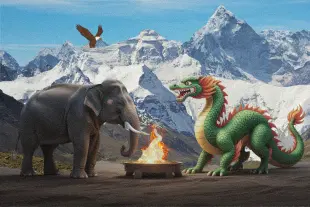World
The Elephant And The Dragon: Why Realpolitik Demands A Risky Rapprochement With China
Gautam Desiraju and Deekhit Bhattacharya
Sep 04, 2025, 05:34 PM | Updated 05:34 PM IST
Save & read from anywhere!
Bookmark stories for easy access on any device or the Swarajya app.


'The time has come,' the Elephant said,
To talk of many things:
Of tariffs, pharmaceuticals, and rare earthlings,
Of Arunachal, Tibet, and Aksai Chins,
And why Eurasia is boiling hot,
And whether Americans have wings.
With apologies to Lewis Carroll.
Global geopolitics and war have, for the most part, been a grave and solemn concern. In the observations of Kautilya, Sun Tzu and Thucydides, and their modern counterparts like Jomini, Huntington and Mearsheimer, one sees that conflict and subterfuge overhang the political calculus of nations.
Utopian liberalism, typified by Fukuyama’s end of history edict, has itself ended, along with the USA’s unipolar status. The first half of 2025 alone has seen an unprecedented 11 percent decline in the value of the US dollar, ending a fifty-year one-way bull run.
The inability of the US to sacrifice its hegemonic ambitions, even when faced with economic and military limitations, is leading to global schizophrenia. The tariff saga has effectively corralled India into reviving dialogue with China under a watchful yet benign Russian gaze. The assumptions that held up the world as we knew it are giving way, and a new world order is emerging.
All this has resulted from the inability of the US to frame coherent plans or objectives for itself under the Trump administration. It oscillates between isolation and empire building on a daily basis. Strategic thinking has been replaced by an aggressive recklessness rooted in short-termism. Bilateral and multilateral relations in the world are changing rapidly as responses to US policy swings, particularly in India, China, Canada, and Europe, the chief targets of the US.
India is facing the simultaneous brunt of regime change operations through covert action by organised entities and a trade war being waged in full public view. China too is facing a systematic denial of technologies and trade from the US and is anxious in the face of American military presence or support across its land and maritime borders.
Much of America’s strategic efforts with respect to India rested on two pillars. The first was to prevent a strong government in Delhi from taking shape that may be able to advance India’s interests with impunity. The second was to prevent any sustainable working relationship from emerging with China, so that American support, read vassalisation, could be presented as an inevitable and inescapable guarantee for Indian well-being.
As a result, all sorts of nefarious methodologies are being deployed. One example is pitting castes against each other, with Navarro’s obnoxious insinuation that Brahmins are somehow profiting from the Russian oil trade being the latest case. Another example is the delegitimisation of elected governments by tarnishing critical institutions, which is presumably US-inspired geopolitical activity.
India’s best bet is to do whatever it takes to become an economy with a GDP of 10 to 12 trillion dollars as soon as possible. At that point, such methods of destabilisation will be essentially rendered unviable. To reach that point requires dispassionate realpolitik, including cutting deals with rivals such as China. America is now an existential enemy to be dealt with, and illusions concerning any bonds of brotherhood beyond polemics and platitudes will find no takers.
Chinese concerns are likewise worth considering. China’s objective is to make the world bipolar rather than multipolar and, if possible, even unipolar in its own favour. However, there are three major obstacles in its path.
The first is that its exports and capital machinery are tied to the largesse of American consumption, and the economic interdependence between the two countries is so great that Niall Ferguson coined the term Chimerica to describe them. Efforts to boost domestic consumption as an alternative have shown muted results at best.
The second obstacle is that the Chinese demographic window is closing rapidly, and it remains to be seen how much of the impact can be mitigated by AI and robotics.
The third is the repeated misallocation of capital, illustrated by the Evergrande collapse and the ongoing wave of bankruptcies in the state-pampered semiconductors and solar energy sectors. This has led to systemic vulnerabilities such as ballooning private credit and a youth that is increasingly demoralised.
The Indian market, which can absorb capital and finished goods alike, is a convenient bypass for China. The Indian demographic window also permits China to prolong the economic shelf life of its current model of growth, buying a few additional years to discover a suitable course of action for the future.
It is true that two suns cannot shine in the same sky, as the Mandarin proverb goes. Until recently, India and China had no fundamental differences. Neither the border dispute nor trade relations were insurmountable or pressing enough to jeopardise broader engagement.
Following Operation Sindoor, India has already established credible deterrence against any Chinese misadventure, direct or via proxies, and China has responded in a surprisingly mature manner. However, India’s economic rise is predicated on unseating China from many of the product and geographical niches it currently occupies. For the first time in the two countries’ histories, a fundamental economic and strategic contradiction has emerged.
While short-term concerns align in terms of mutual economic agendas to insulate themselves against the next American whiplash, the medium to long term is far trickier and perhaps more prone to conflict than ever before. Rapprochement, as real as it may be today, will have an expiry date that both countries will be constantly second-guessing.
It is in the mutual interests of China and India to engage in comprehensive and fair economic exchanges. For India, rare earths, pharmaceutical precursors, capital, and technology will be desirable. Predatory dumping and IP theft will need to take a back seat.
The modus vivendi between the two countries is poised to be overwhelmingly cooperative, albeit in a piecemeal, sectoral fashion, in no small way thanks to the shared hazard that is America. However, India’s economic rise will inevitably lead to Chinese losses, both in absolute and relative terms, especially in certain critical sectors and their related supply chains.
This point is well recognised by the Chinese, who are already denying capital, technologies, and personnel to Indian units engaged in sectors such as electronics. China knows that India may do to China what China once did to the West’s manufacturing.
It is instructive to remember that at the cusp of the First World War, Germany and the UK were each other’s largest trade partners and depended on each other for critical resources and capital goods. This situation is eerily reflected in China-America and India-China relations a century later.
Gone are the days of enduring all-encompassing partnerships. Transactionalism and compartmentalism, which are also subject to strict timelines, are the only ways forward for India.
Reassuringly and rather suggestively, the Raksha Mantri recently paraphrased Lord Palmerston: there are no permanent friends or permanent enemies, only permanent interests.
Gautam R. Desiraju (IISc Bangalore and UPES Dehradun) and Deekhit Bhattacharya (Luthra and Luthra Law Offices India) Views are personal to the authors.




